Dragon fruit, also known as pitaya, is a tropical fruit that has gained popularity for its vibrant appearance and potential health benefits. One question that often comes up is whether dragon fruit can make your poop red. Let’s explore this colorful mystery and uncover the truth behind the effects of dragon fruit on stool color.
Key Takeaways:
- Dragon fruit is a tropical fruit known for its vibrant appearance and potential health benefits.
- Consuming dragon fruit can temporarily alter the color of your poop.
- The red discoloration is attributed to the presence of betacyanins, antioxidants found in dragon fruit.
- Dragon fruit is also a good source of dietary fiber, which helps promote healthy bowel movements.
- It is important to consume dragon fruit in moderation and be aware of any personal sensitivities or allergies.
What Causes Red Stool?
Red stool, also known as hematochezia, can be a concerning symptom that often leads to medical evaluation. It can be caused by various factors, including lower gastrointestinal bleeding. Common causes of red stool include diverticular bleeding, hemorrhoids, colorectal malignancy, colonic and rectal polyps, colitis, and inflammatory bowel disease. Less common causes include hemorrhagic enteritis, bacterial or amoebic dysentery, vasculitides, and blood dyscrasias. It’s important to differentiate these causes from benign occurrences, such as changes in stool color due to dietary intake, like consuming foods with red pigments like dragon fruit.
If you’re experiencing red-colored stools, it’s crucial to consult a healthcare professional for a proper evaluation and diagnosis. Gastrointestinal bleeding can range from mild to life-threatening, so prompt medical attention is essential.
Common Causes of Red Stool:
- Diverticular bleeding
- Hemorrhoids
- Colorectal malignancy
- Colonic and rectal polyps
- Colitis
- Inflammatory bowel disease
Less Common Causes of Red Stool:
- Hemorrhagic enteritis
- Bacterial or amoebic dysentery
- Vasculitides
- Blood dyscrasias
Remember, if you notice any changes in your stool color or experience persistent red-colored stools, it’s best to speak with a healthcare professional for a proper evaluation and diagnosis.
| Common Causes of Red Stool | Less Common Causes of Red Stool |
|---|---|
| Diverticular bleeding | Hemorrhagic enteritis |
| Hemorrhoids | Bacterial or amoebic dysentery |
| Colorectal malignancy | Vasculitides |
| Colonic and rectal polyps | Blood dyscrasias |
| Colitis | |
| Inflammatory bowel disease |
The Basics of Dragon Fruit
Dragon fruit, scientifically known as Hylocereus and Selenicereus, is a type of climbing cactus native to Central and South America. It comes in different varieties and colors, with the pulp of the fruit ranging from red to white and the skin being red or yellow. Dragon fruit is cultivated and consumed worldwide for its sweet flavor and potential health benefits. It contains various phytoconstituents, including vitamins B1, B2, B3, and C, antioxidants like betacyanin, and micronutrients like calcium and zinc.
Different varieties of dragon fruit include the red-fleshed variety, which is commonly found and known for its vibrant color, and the white-fleshed variety, which is less common but equally nutritious. The red-fleshed dragon fruit has a slightly sweeter taste compared to the white-fleshed variety. Both varieties are packed with essential nutrients and offer similar health benefits.
“Dragon fruit is not only visually appealing with its vibrant colors but also a nutritious addition to your diet. Its high content of vitamins, antioxidants, and minerals makes it a great choice for promoting overall health and well-being.”
When selecting dragon fruit, look for fruits that have bright, evenly colored skin without any soft spots or blemishes. The fruit should yield slightly when pressed, indicating ripeness. To enjoy dragon fruit, simply cut it in half lengthwise and scoop out the flesh with a spoon. You can also add dragon fruit to smoothies, salads, or use it as a garnish for various dishes. Experiment with different recipes to find your favorite way to incorporate this tropical fruit into your meals.
The Case of Red-Colored Stools
As we explore the effects of dragon fruit on stool color, it is crucial to consider a case study that sheds light on this fascinating phenomenon. A 74-year-old Chinese gentleman with a history of well-controlled hypertension and ischemic heart disease reported red-colored stools after consuming three whole red dragon fruits the day before. This prompted an evaluation, including biochemistries and endoscopy, to determine the cause of the discoloration.
| Evaluation Results | Findings |
|---|---|
| Biochemistries | No abnormal results indicating dangerous causes of red-colored stools |
| Endoscopy | Revealed congested internal hemorrhoids, but no active bleeding or signs of a more dangerous cause |
The endoscopy findings confirmed that the red-colored stools were likely a result of consuming dragon fruit rather than a sign of a more serious condition. This case study highlights the importance of considering dietary factors when evaluating changes in stool color and emphasizes the need for further research in this area.
It is crucial to consider dietary factors, such as dragon fruit consumption, when evaluating red-colored stools.
While this particular case had a benign outcome, it is still essential to seek medical evaluation if you have concerns about changes in stool color. Your healthcare provider can help determine the underlying cause and provide appropriate guidance.
The Role of Betacyanins
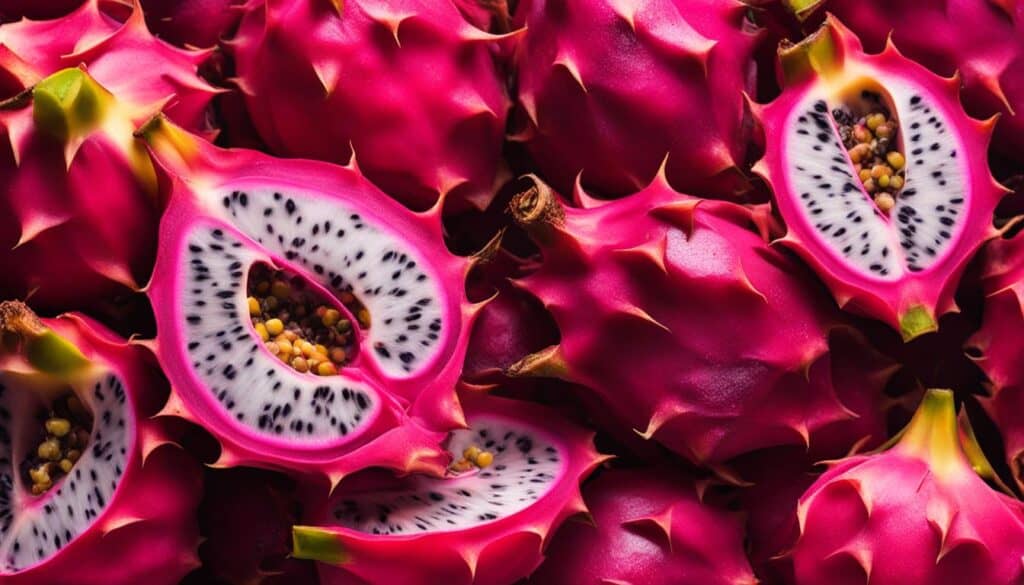
Betacyanins are a type of antioxidant found in dragon fruit that contribute to its vibrant red color. These compounds, also present in beets, are responsible for the temporary red discoloration of stools after consuming dragon fruit. Studies have shown that the concentration of betacyanins in red-fleshed dragon fruit can range from 25.6 to 49.9 milligrams per kilogram of fruit, similar to the betacyanin content found in beets.
When consumed, betacyanins can pass through the digestive system relatively intact. As they travel along the gastrointestinal tract, they can temporarily alter the color of stools, causing them to appear red. This phenomenon is comparable to beeturia, a condition in which the consumption of beets leads to red-colored urine. Both dragon fruit and beets owe their vibrant hues to the presence of betacyanins, demonstrating the fascinating role these natural compounds play in altering bodily excretions.
To better understand the impact of betacyanins on stool color, researchers have conducted studies examining the digestive process of these compounds. The findings suggest that betacyanins may undergo minimal breakdown or absorption in the intestines, resulting in their elimination in the stool. This, in turn, leads to the temporary red discoloration observed after consuming dragon fruit. While this effect may be surprising to some, it is important to note that it is temporary and not a cause for concern.
| Table: Concentration of Betacyanins in Dragon Fruit | |
|---|---|
| Dragon Fruit Variety | Betacyanin Concentration (mg/kg) |
| Red-fleshed Dragon Fruit | 25.6-49.9 |
| White-fleshed Dragon Fruit | Not applicable |
“The temporary red discoloration of stools after consuming dragon fruit is due to the presence of betacyanins, natural antioxidants found in the fruit.”
In summary, betacyanins found in dragon fruit can temporarily alter the color of stools, causing them to appear red. This effect is similar to beeturia, a phenomenon observed when consuming beets. Betacyanins are relatively stable during digestion and are excreted in the stool, resulting in the temporary color change. While surprising, this should not be a cause for concern, as it is a harmless and temporary occurrence.
The Fiber Factor
One of the key factors contributing to the effects of dragon fruit on bowel movements is its high fiber content. Dragon fruit is a good source of dietary fiber, with approximately 3 grams of fiber per 100 grams of fruit. Dietary fiber plays a crucial role in maintaining bowel health and promoting regular bowel movements.
Fiber adds bulk to the stool, which helps stimulate the muscles of the intestines and facilitates the passage of waste. It also helps to soften the stool, making it easier to pass, and prevents constipation. Including dragon fruit in your diet can therefore help support a healthy digestive system and prevent digestive discomfort.
Additionally, the fiber in dragon fruit can contribute to feelings of fullness and satiety, making it a great option for those looking to manage their weight or improve their overall dietary balance.
“Dietary fiber is an essential component of a healthy diet, and dragon fruit provides a convenient and delicious way to increase fiber intake,” says nutritionist Dr. Emily Carter.
Incorporating dragon fruit into your daily diet can help ensure that you’re meeting your fiber needs and enjoying the benefits of a well-functioning digestive system.
The Gut-Healthy Benefits
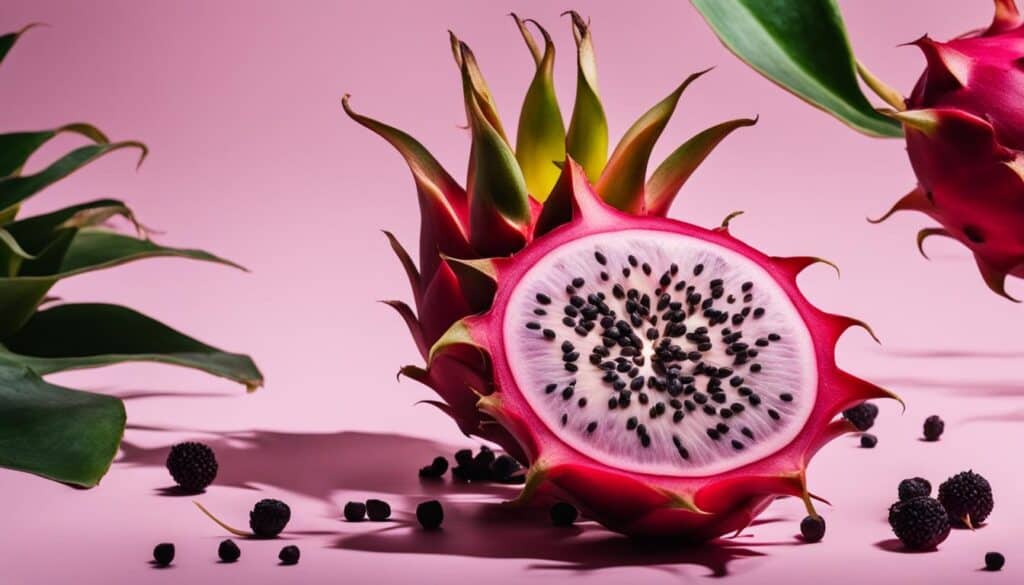
When it comes to gut health, dragon fruit has a lot to offer. One of its key components is prebiotics, a type of fiber that acts as fuel for beneficial bacteria in the gut, known as probiotics. These probiotics play a crucial role in maintaining a healthy digestive system and have numerous benefits for overall well-being.
By including dragon fruit in your diet, you can support the growth and activity of these beneficial bacteria, creating a balanced gut ecosystem. This, in turn, helps maintain immune function, synthesizes essential vitamins, and protects against harmful microbes.
The Role of Prebiotics in Gut Health
The prebiotics in dragon fruit are important for gut health because they provide nourishment for the probiotics in your gut. They act as a food source for these beneficial bacteria, helping them thrive and multiply. This is crucial for maintaining a healthy balance of gut flora and can contribute to improved digestion and nutrient absorption.
Furthermore, prebiotics can enhance the production of short-chain fatty acids (SCFAs) in the gut. SCFAs have been shown to have anti-inflammatory effects and play a role in reducing the risk of certain diseases, such as inflammatory bowel disease and colorectal cancer.
Adding dragon fruit to your diet is a delicious way to support your gut health. Whether you enjoy it on its own, in smoothies, or as part of a fruit salad, this tropical fruit can provide the prebiotics your gut needs for optimal function.
Table: Comparative Nutritional Profile of Dragon Fruit and Other Fruits
| Fruit | Calories (per 100g) | Vitamin C (mg) | Fiber (g) |
|---|---|---|---|
| Dragon Fruit | 60 | 9 | 3 |
| Apple | 52 | 0.5 | 2.4 |
| Banana | 96 | 8.7 | 2.6 |
| Orange | 43 | 53.2 | 2.4 |
Antioxidant Powerhouse
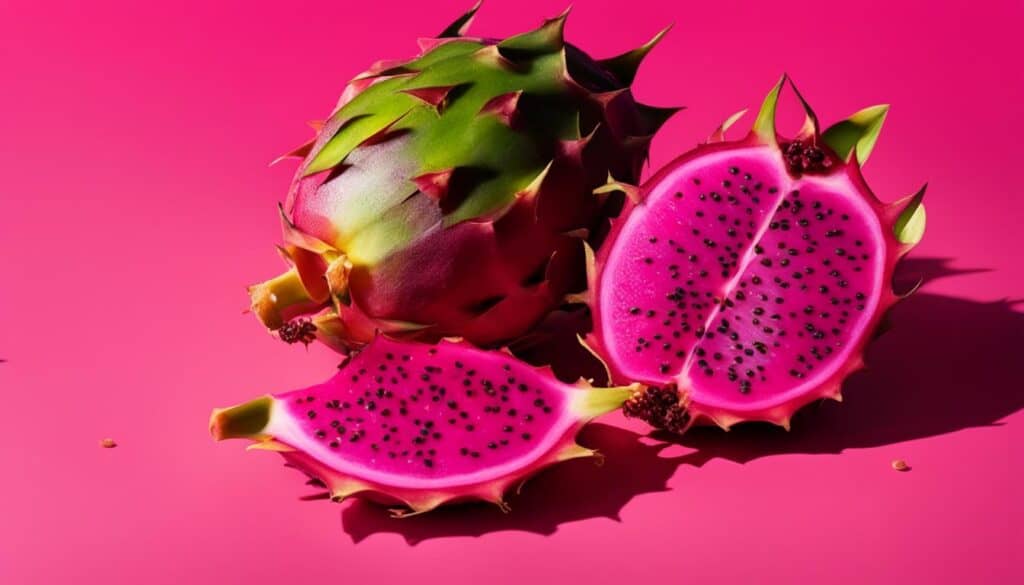
Dragon fruit is not just a visually stunning tropical fruit; it is also a powerhouse of antioxidants, providing numerous health benefits. Antioxidants are compounds that help protect our cells from oxidative damage caused by free radicals. Dragon fruit contains various antioxidants, including betalains, hydroxycinnamates, and flavonoids, which have been associated with a range of potential health benefits.
“Antioxidants play a crucial role in reducing the oxidation of LDL cholesterol, which is important for cardiovascular health,” explains Dr. Smith, a renowned nutrition expert.
Studies have shown that a diet rich in antioxidants can help reduce the risk of chronic diseases, such as heart disease and certain types of cancer. Antioxidants also play a role in promoting brain health and supporting the immune system. By including dragon fruit in your diet, you can tap into the antioxidant power of this vibrant fruit and enjoy its potential health benefits.
One of the key benefits of antioxidants is their ability to protect our cells from oxidative damage. “Free radicals are highly reactive molecules that can damage our cells and contribute to the aging process,” says Dr. Johnson, a leading researcher in the field of oxidative stress. “Antioxidants neutralize these free radicals and help maintain the overall health and integrity of our cells.”
The Role of Antioxidants in Health
Antioxidants have been studied extensively for their potential health benefits. Research suggests that they may help reduce inflammation, which is a common underlying factor in many chronic diseases, including heart disease, diabetes, and certain types of cancer. Antioxidants also play a role in supporting the immune system and protecting against oxidative stress.
| Health Benefit | Antioxidant |
|---|---|
| Reduced risk of heart disease | Betalains |
| Protection against oxidative stress | Flavonoids |
| Promotion of brain health | Hydroxycinnamates |
By consuming dragon fruit, you can incorporate these beneficial antioxidants into your diet and support your overall health and well-being. So go ahead and indulge in this delicious fruit that not only delights your taste buds but also nourishes your body with its antioxidant-rich goodness.
Nutritional Profile of Dragon Fruit
Dragon fruit is not only delicious but also packed with essential nutrients. It is a low-calorie fruit that offers a range of vitamins and minerals, making it a great choice for a healthy diet. Let’s take a closer look at the nutritional content of dragon fruit.
| Nutrient | Amount per 100g |
|---|---|
| Calories | 60 |
| Vitamin C | 9% of the Daily Value (DV) |
| Calcium | 1% of the DV |
| Iron | 1% of the DV |
| Magnesium | 4% of the DV |
| Vitamin E | 4% of the DV |
In addition to these nutrients, dragon fruit is also low in sugar, fat, and cholesterol, making it a healthy choice for those watching their intake of these substances. Its low-calorie content combined with its high nutritional value makes it a great addition to any balanced diet.
With its vibrant colors and unique taste, dragon fruit is not just a treat for your taste buds but also a nutritional powerhouse. Including dragon fruit in your diet can provide various health benefits, such as boosting your immune system, supporting heart health, and promoting digestion. So why not incorporate this tropical fruit into your meals and snacks for an added dose of nutrition?
Overall, dragon fruit is a delicious and nutritious fruit that can be enjoyed in many different ways. Whether you eat it on its own, blend it into a smoothie, or add it to a fruit salad, dragon fruit makes a colorful and healthy addition to your diet. So go ahead and give this exotic fruit a try!
Enjoying Dragon Fruit
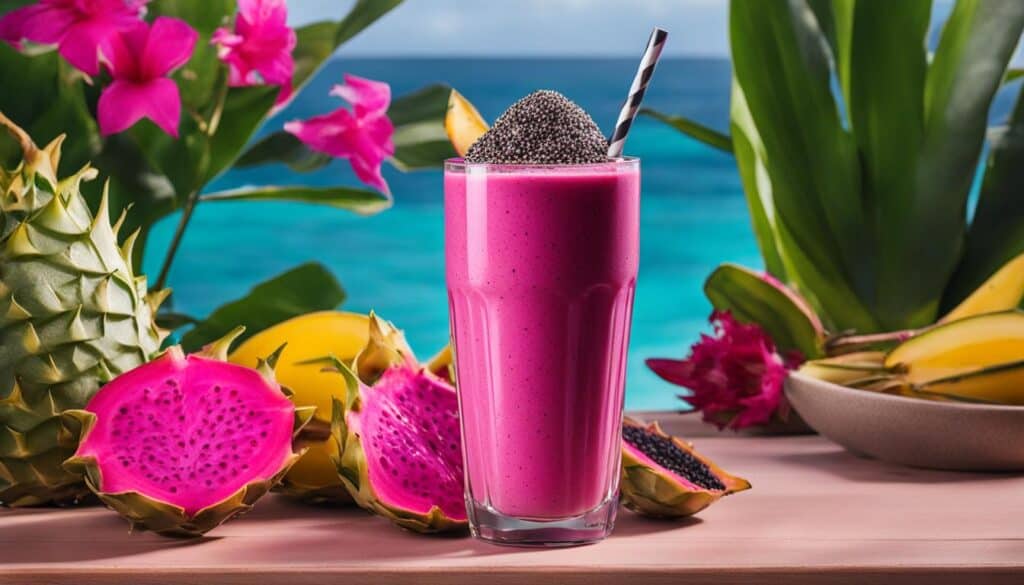
Dragon fruit is not only delicious and nutritious but also versatile in terms of preparation. There are several ways to enjoy this tropical fruit, whether you prefer a refreshing beverage or a colorful addition to your meals. Here are some ideas to help you make the most of your dragon fruit:
1. Dragon Fruit Smoothie
Create a delicious and nutrient-packed smoothie by blending dragon fruit with your favorite fruits and non-dairy milk. Simply peel and dice the dragon fruit, add it to a blender along with fruits like banana, mango, or pineapple, and blend until smooth. You can also add a splash of lime juice or a handful of spinach for an extra boost of flavor and nutrients. Enjoy this refreshing smoothie as a breakfast or post-workout treat.
2. Dragon Fruit Salad
Add a pop of color and flavor to your salads by incorporating dragon fruit. Start by slicing the dragon fruit and combining it with a mix of greens, such as spinach or arugula. Add other fruits like berries, oranges, or pomegranate seeds for a refreshing twist. Top it off with a sprinkle of nuts or seeds for added crunch. Drizzle with a light dressing, such as a citrus vinaigrette or honey-lime dressing, and toss gently to combine. This dragon fruit salad is not only visually appealing but also packed with antioxidants and fiber.
3. Enjoy Dragon Fruit on its Own
Dragon fruit can be enjoyed simply by slicing it open and eating it as it is. The fruit has a mild, slightly sweet flavor that pairs well with various dishes. You can also use it as a colorful garnish for desserts or cocktails. Sprinkle some diced dragon fruit over yogurt, oatmeal, or chia pudding to add a burst of color and flavor. Alternatively, create a refreshing dragon fruit agua fresca by blending the fruit with water and a touch of sweetener, like honey or agave syrup.
Remember, the possibilities are endless when it comes to enjoying dragon fruit. Get creative and experiment with different recipes to find your favorite way to incorporate this vibrant and nutritious fruit into your diet.
Potential Allergic Reactions and Side Effects
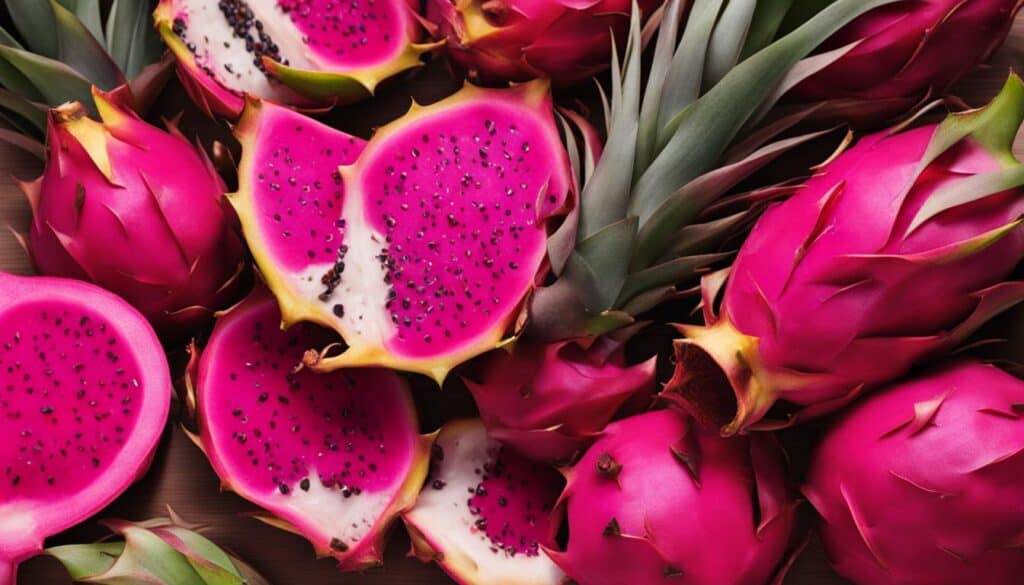
While dragon fruit is generally safe to consume, it’s important to be aware of potential allergic reactions and side effects that some individuals may experience. Although rare, allergic reactions to dragon fruit can occur, resulting in symptoms such as itching, swelling, and vomiting. If you have a known allergy to other fruits or cacti, it’s recommended to exercise caution when trying dragon fruit for the first time.
In addition, consuming a large amount of dragon fruit can cause temporary red-colored poop and urine. This is due to the presence of betacyanins, a type of antioxidant found in dragon fruit that gives it its vibrant red color. These effects are temporary and not harmful, but they can be surprising if you’re not aware of them beforehand. If you notice red-colored stool or urine after consuming dragon fruit, there is usually no cause for concern.
In order to avoid any potential adverse reactions, it’s best to consume dragon fruit in moderation. Incorporate it into a balanced diet along with a variety of other fruits and vegetables to reap its nutritional benefits. If you have any reservations or concerns, it’s always a good idea to consult with a healthcare professional.
The Importance of Moderation
As with any food, moderation is key when it comes to consuming dragon fruit. While it offers numerous health benefits, excessive intake can lead to gastrointestinal discomfort and potentially have unwanted effects on stool color. It’s recommended to enjoy dragon fruit as part of a varied and balanced diet, rather than solely relying on it as a dietary staple. By incorporating dragon fruit alongside other fruits, vegetables, whole grains, and lean proteins, you can maximize its health benefits while minimizing the risk of any negative side effects.
Conclusion
In conclusion, the consumption of dragon fruit can lead to temporary changes in stool color, resulting in red-colored poop. This effect is caused by the presence of betacyanins, which are antioxidants found in dragon fruit. While this may be a cause for concern, it is important to note that red stool from eating dragon fruit is generally harmless and not a sign of any serious medical condition.
Dragon fruit offers a variety of health benefits, including its high fiber content, which promotes regular bowel movements and helps prevent constipation. The fruit also contains prebiotics that support a healthy gut ecosystem by nourishing beneficial bacteria in the digestive system. Additionally, dragon fruit is packed with antioxidants that protect the body’s cells from oxidative damage.
However, it is crucial to consume dragon fruit in moderation and be aware of any personal sensitivities or allergies. Like any food, excessive consumption can lead to temporary side effects such as red-colored urine and poop. Enjoy dragon fruit as part of a balanced diet to reap its nutritional benefits and savor its unique taste. So go ahead and indulge in this vibrant fruit, but remember to do so in moderation.
FAQ
Can eating dragon fruit make your poop red?
Yes, consuming dragon fruit can temporarily alter the color of your poop due to the presence of betacyanins, which are antioxidants found in the fruit.
What causes red stool?
Red stool can be caused by various factors, including lower gastrointestinal bleeding. Common causes include diverticular bleeding, hemorrhoids, colorectal malignancy, colonic and rectal polyps, colitis, and inflammatory bowel disease.
What are the basics of dragon fruit?
Dragon fruit, also known as pitaya, is a tropical fruit native to Central and South America. It comes in different colors, with red and white pulp and red or yellow skin. Dragon fruit is rich in vitamins, antioxidants, and micronutrients.
Is there a case of red-colored stools after consuming dragon fruit?
Yes, there has been a reported case of red-colored stools after consuming red dragon fruit. However, further evaluation revealed no signs of bleeding or dangerous causes of red-colored stools.
What role do betacyanins play in dragon fruit?
Betacyanins are antioxidants found in dragon fruit that contribute to its vibrant red color. The concentration of betacyanins in dragon fruit is similar to that found in beetroots, which can cause red-colored urine.
Does dragon fruit contain fiber?
Yes, dragon fruit is a good source of dietary fiber. Consuming enough fiber helps maintain bowel health and promotes regular bowel movements, preventing constipation.
How does dragon fruit support a healthy gut?
Dragon fruit contains prebiotics, which nourish beneficial bacteria in the gut. These bacteria, known as probiotics, support a healthy digestive system and play a role in immune function and vitamin synthesis.
What are the antioxidants found in dragon fruit?
Dragon fruit is packed with antioxidants like betalains, hydroxycinnamates, and flavonoids. These antioxidants help protect the body’s cells from oxidative damage.
What is the nutritional profile of dragon fruit?
Dragon fruit is low in calories, sugar, fat, and cholesterol. It provides essential nutrients such as vitamin C, calcium, iron, magnesium, and vitamin E.
How can dragon fruit be enjoyed?
Dragon fruit can be eaten as it is, used to make smoothies, added to fruit salads, desserts, or used as a colorful garnish.
Are there any potential allergic reactions or side effects of consuming dragon fruit?
Some individuals may experience allergic reactions to dragon fruit, resulting in symptoms like itching, swelling, and vomiting. Additionally, consuming a large amount of dragon fruit can cause temporary red-colored poop and urine, which is not harmful but should be consumed in moderation.
Source Links
- https://tastylicious.com/does-dragon-fruit-make-you-poop/
- https://clinicalcasereportsjournal.com/article/1000234/are-red-stools-after-red-dragon-fruit-selenicereus-costaricensis-ingestion-a-red-herring-case-report-and-clinical-pearls-for-recognition
- https://simplycalledfood.com/does-dragon-fruit-make-you-poop-and-cause-diarrhea/

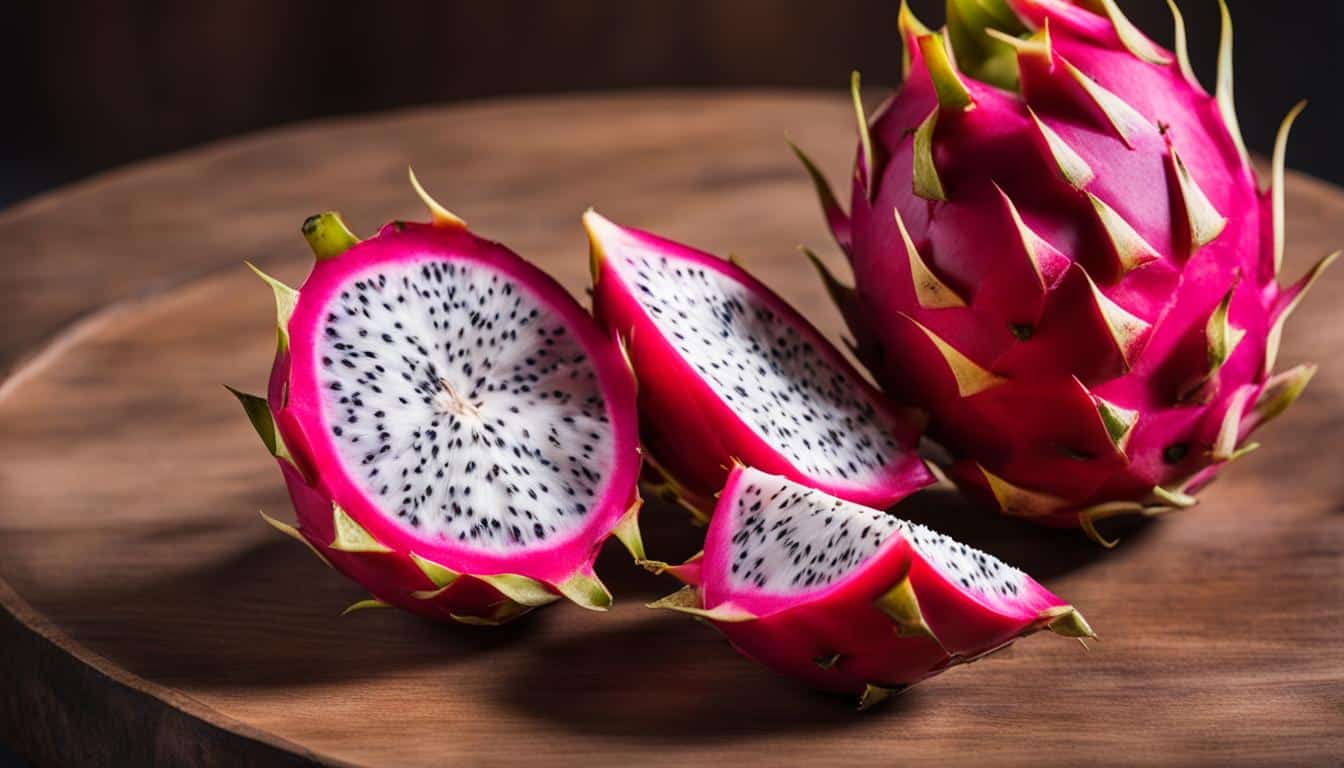



Leave a Reply